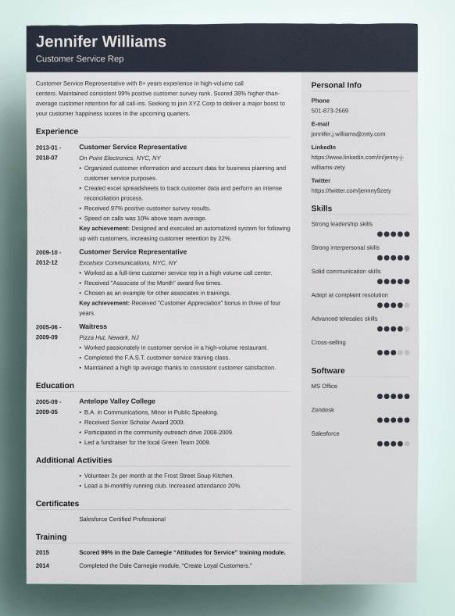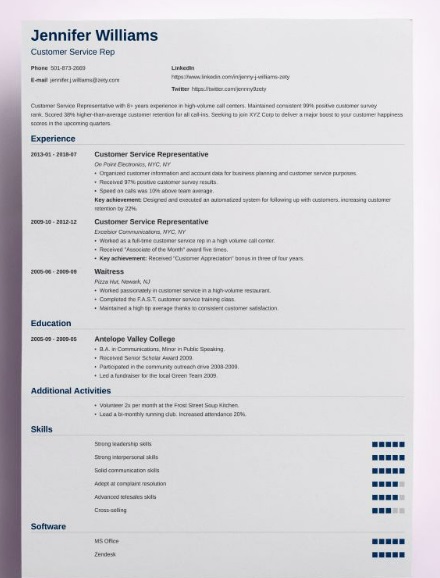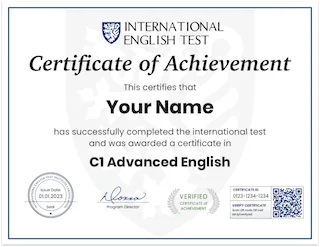What belongs on a resume? Contact details, an opening statement, work history, education, skills… Seems straightforward, right? But what about career goals? A cover letter? If you still feel like you might be overlooking something, here’s a comprehensive guide covering the crucial elements to include on a resume, ensuring you have everything you need.
You are already aware of the essential resume sections: Contact Information, Resume Profile, Work History, Education, and Skills.
Additionally, there are some optional sections you can consider, such as achievements, certifications, or a hobbies section.
The flexibility also exists to rearrange sections based on your information prioritization. For instance, in the case of a high school student resume or a first job resume, placing education above work experience might be more suitable.
Depending on the resume format, the order of key sections may vary.
Regardless of the section order you choose, keep in mind that each section has crucial elements that should be included in your resume.
Before delving into each resume section, consider this: Crafting a resume can be challenging and time-consuming. Fortunately, you can simplify the process by selecting one of Zety’s templates. This ensures that your resume includes all necessary components, providing tips and ready-to-use content for each section.
Explore sample resumes created with the most attractive and professional templates in our builder. Observe how well-organized they are, incorporating all key pieces of information.
What is your English level?
Find out your A1 A2 B1 B2 C1 C2 level of English with our quick, free online test.
Sample Resumes That Include All the Key Sections
Newcast
Finally, introducing Newcast. This resume template facilitates recruiters in efficiently navigating through essential sections from the top down. It stands out as one of the most minimalistic yet elegant options in our collection. With a traditional layout and ample white space, it avoids gimmicks—making it an ideal choice for academic admission applications or positions in research.

Diamond
This resume format is widely favored by individuals in the business and finance sectors. Once more, key information takes center stage, highlighted by professionally crafted headings.

Cubic
Yet another resume template, Cubic, facilitates improved organization of information through its double-column layout. If you wish to include additional details such as courses, extra activities, or certifications, Cubic allows for all of that while maintaining a concise one-page format. Particularly suitable for senior candidates.

What is your English level?
Find out your A1 A2 B1 B2 C1 C2 level of English with our quick, free online test.
Nanica
The standout feature of this template? Major sections are instantly recognizable due to prominent and large headings. This design facilitates drawing attention to the most crucial information. Moreover, the resume layout is conservative and straightforward, making it an ideal choice for corporate job applications.

Primo
Another design that aids in presenting all information in a well-structured manner is Primo. It incorporates a timeline for both your work history and education, simplifying the process of navigating through your career evolution. Essential sections are accentuated with small icons, and the two-column layout facilitates the inclusion of more information on a single page. This template is highly adaptable, suitable for both conventional and creative job applications.

Now, let’s go through all key sections you should put on your resume:
1. Contact Information
The contact details on your resume comprise:
– Your Full Name
– Professional Title
– Phone Number (Ensure it’s one you readily answer.)
– Professional Email
– Social Media Handles (Twitter and LinkedIn)
– URL to Your Personal Website, Blog, or Portfolio
In the current context, including your address is optional, particularly if you’re seeking a position in a different state or country. Omitting your current address can prevent confusion, especially when applying for non-local jobs.
2. Experience Section
The experience section serves as the core of your resume.
Initially, it’s unnecessary to enumerate every job you’ve held. Include only those from the last ten or fifteen years or those directly relevant to the position you’re seeking. However, avoid substantial gaps in your job history.
Now, what elements should you incorporate into your experience section?
A list of relevant jobs in reverse-chronological order, starting with your current position
If you have experience with a less recognized company, consider providing a brief description.
Include one or two lines explaining the company’s nature and operations beneath its name before delving into the bullet points detailing your responsibilities.
Up to six bullet points describing your roles and responsibilities at each job
Attempt to incorporate responsibilities that mirror the skills outlined in the job description and align most closely with the position you are seeking.
When crafting your bullet points, initiate with an action verb. Being mindful of the structure of your bullet points enhances the readability of your resume.
Commence with an Action Verb. Present a Quantifiable Point. Conclude with a Specific Task.
Example:
Action Verb: Spearhead
Quantifiable Point: Newsletter registration up 15%
Specific Task: Executed a marketing campaign
Initiated and executed an email marketing campaign that resulted in a 15% increase in newsletter registrations.
Achievements illustrated with facts and figures
Following the enumeration of a responsibility, reflect on whether you accomplished any notable achievements in executing that task. Did you enhance sales or elevate customer satisfaction? Did you successfully conclude a project ahead of schedule?
If possible, incorporate numerical or concrete details to exemplify your accomplishments – this is even more beneficial. Numbers capture the recruiter’s attention, and details assist them in envisioning you replicating such results for their benefit.
This underscores the importance of integrating your achievements into your resume, proving to be one of the most advantageous actions for enhancing your experience section.
Internships – but only if you have limited work experience
For recent graduates, it’s perfectly acceptable – and even advisable – to include your internships on your resume. However, if you have accumulated several years of work experience, it’s time to bid farewell to the internships section.
The sole exception to this guideline is if you underwent a high-profile internship within a widely recognized organization that is directly relevant to the position you are applying for.
Incorporate key skills strategically throughout your experience section, ensuring alignment with the job requirements. Extract crucial information from the job advertisement as potential keywords for your resume.
Feel free to list “non-traditional” work, such as volunteer roles or freelance engagements, particularly if you have been without a regular job for an extended period.
3. A Resume Summary or Objective
A challenging decision: what to place at the start of your resume following your contact information?
Commencing a resume with a summary or objective presents a valuable opportunity.
However, the dilemma is: which one to opt for?
The resume objective is more fitting for:
– Students
– Scholarship applications
– Internship seekers
– Entry-level candidates
– Individuals lacking work experience
– Career changers
– Job seekers with career gaps
For everyone else, a resume summary is recommended.
Both serve as brief and impactful introductions meant to highlight your career trajectory and skill set.
In cases where career progression is limited, craft two or three lines providing recruiters insight into your current professional standing and future aspirations.
Producing a professional resume career summary is challenging, especially when grappling with how to compose a resume objective.
The crucial point to remember in both instances is that you are no longer conveying your desires to an employer. You can distill it down to just a few words using our formula for resume titles.

4. Education Section
The education section can be positioned either after the experience section or placed before, especially if you have recently graduated.
What elements should be incorporated?
A compilation of your degrees and the corresponding institutions.
Present your education section in reverse-chronological order, starting with your most recent degree.
If you hold advanced degrees, there’s no necessity to include details about the high school you attended.
Details about your field of study.
Including a description of what you studied is optional, but for recent graduates, those wishing to emphasize their studies, or those deeming it particularly relevant to the job, it can be included.
Any recognitions and accolades you earned.
A standard entry in your education section should encompass your degree type, major, university name, and any honors or awards received, presented in the following format:
Honors BA in English Literature, Purdue University, Salutatorian
Are you C1 Advanced English?
Get your C1 Advanced English certificate now!
✓ Add your certificate to your resume
⭐ ⭐ ⭐ ⭐ ⭐
5. Skills to Grab a Recruiter’s Attention
When contemplating resume content, skills take precedence as the most crucial element.
The skills section entails a compilation of your top capabilities.
It’s essential to include as many skills from the job description as feasible; these are your keyword skills, aligning with what recruiters seek.
Beyond the job-specific keyword skills, certain universally valuable skills should be incorporated on any resume if possessed.
Here are a few:
- Effective communication (both written and verbal)
- Leadership
- Planning and strategic thinking
- Analytical thinking and research
- Teamwork or collaborative work
Disperse your skills strategically within your experience section, reserving the most prominent ones for a dedicated skills section. When your resume is scrutinized by Applicant Tracking System (ATS) software, a conventional skills section is the optimal location for showcasing your skill set.
An alternative approach to incorporating skills is through the creation of an infographic resume. Infographic resumes use visuals to present complex information in a straightforward manner. However, it’s essential to note that infographic resumes carry risks; ATS systems struggle to interpret them, and many recruiters are not fond of this format.
Infographic resumes should be viewed as supplementary and not a replacement. It’s still advisable to have a traditional resume to ensure broad compatibility and appeal.
6. Hobbies
Incorporating a section for hobbies and interests in your resume is a highly beneficial suggestion, particularly if you have surplus space.
Numerous companies are increasingly valuing aspects of personality and assessing how well an individual would integrate into their team and the overall company culture.
While not obligatory, including a hobby section provides an excellent opportunity to showcase your personality and distinguish yourself. It is certainly a worthwhile consideration for inclusion on your resume.

7. Other Additional Sections
Apart from the Hobbies and Interests section, there are additional segments you might contemplate incorporating into your resume.
For a student’s resume, struggling to fill content, you could consider introducing separate sections for awards and honors, or additional activities, including extracurricular pursuits.
In case of a technical background, you might find it beneficial to include a distinct section for certificates, licenses, or software proficiencies.
Professionals opting for a resume over a CV may still find relevance in adding sections that highlight publications or conference attendance.
Alternatively, you can introduce other sections to spotlight specific strengths, such as proficiency in multiple foreign languages.
Regardless of your choices, ensure that these additional sections complement rather than overwhelm your resume, maintaining an appropriate resume length.
8. Tailor Your Resume To a Job Description
Always ensure to customize your resume according to the job description—this is a pivotal aspect.
Recruiters primarily focus on the skills and experience outlined in the job description during their initial review of your resume.
Incorporate keywords directly from the job description throughout your resume, and consider adding most skills verbatim in either the experience or skills section.
By featuring words directly from the job description, you signal to the hiring manager that your resume is pertinent and that you possess the skill set they seek in a potential candidate.
Explore specific guidance on what to include in a resume tailored to your profession, such as a Part-Time Job Resume, Federal Resume, Teen Resume, Business Resume, IT Professional Resume, or Basic Resume Templates.
What is your English level?
Find out your A1 A2 B1 B2 C1 C2 level of English with our quick, free online test.





